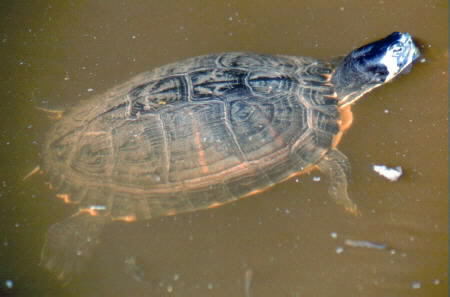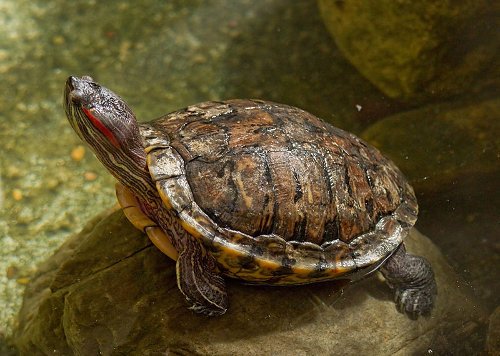The Yellow-Bellied Slider, scientifically known as Trachemys scripta scripta, is a land and water turtle native to the southeastern United States. It is the most common turtle species in its range and belongs to the family Emydidae.
These turtles may bite when they feel threatened, but with proper care, they can be entertaining pets. They have an omnivorous diet and their basking behavior can put them in competition with other native turtle species for food and basking sites.
Although not much is known about their ecological impact, their introduction worldwide has raised concerns about their invasive potential. Yellow-Bellied Sliders are long-lived aquatic turtles, making them an interesting species to study.

Credit: nas.er.usgs.gov
Native Habitat And Characteristics
The yellow-bellied slider, a subspecies of pond slider, is native to the southeastern United States. It is a land and water turtle that can be found from Florida to southeastern Virginia and is the most common turtle species in its range.
Yellow-bellied sliders are entertaining pets if cared for properly, but they may bite if they feel threatened.
Geographical Range
The yellow-bellied slider (Trachemys scripta scripta) is a land and water turtle native to the southeastern United States. Specifically, its range extends from Florida to southeastern Virginia. This subspecies of pond slider is widely distributed and is the most common turtle species within its habitat.
Physical Characteristics
Yellow-bellied sliders have distinct physical characteristics that make them easily recognizable. They have smooth, oval-shaped shells that range in color from olive-green to dark brown, with yellow markings on their underbellies – hence the name “yellow-bellied.” Their skin is typically olive-colored, with dark stripes running down their necks, legs, and tails. As adults, they can grow to be 8-13 inches long, with females being larger than males.
Their limbs are webbed, which helps them swim efficiently. Their heads are also equipped with a pair of prominent yellow stripes, extending from the eyes to the snout. In terms of weight, they can weigh anywhere between 2 to 7 pounds.
Behavior And Temperament
Yellow-bellied sliders are known for their curious and amiable demeanor. While they may not enjoy excessive handling, these reptiles can become more comfortable with human interaction over time. It’s important to handle them with care and provide them with proper accommodations to ensure their well-being.
They are omnivorous and have a varied diet, consuming plants, seeds, insects, crustaceans, tadpoles, and small fish. Their basking behavior is also noteworthy, as they require access to a basking area to regulate their body temperature. This behavior puts them in direct competition with other native turtle species for food and basking sites.
Despite their friendly nature, yellow-bellied sliders may bite when they feel threatened. Therefore, it’s crucial to approach them cautiously and respect their boundaries.
Overall, yellow-bellied sliders make great pets when properly cared for. Their entertaining behavior and unique characteristics make them a popular choice among turtle enthusiasts.

Credit: www.researchgate.net
Ecological Impact And Invasive Species
The yellow-bellied slider turtle (Trachemys scripta scripta) is not only a popular pet but also an invasive species in many regions. Its introduction into non-native habitats has led to significant ecological impacts. Here, we explore two key aspects of its ecological impact: competition for food and basking sites, and impacts on native species.
Competition For Food And Basking Sites
When it comes to food and basking sites, yellow-bellied sliders are highly opportunistic and adaptable. They have a diet that includes plants, seeds, insects, crustaceans, tadpoles, and even small fish, making them direct competitors with native turtle species for limited resources.
These sliders are known to outcompete native turtles by consuming similar food sources and occupying basking sites, such as logs and rocks, which are essential for thermoregulation. The presence of yellow-bellied sliders can therefore disrupt the balance of the ecosystem, affecting the survival and reproduction of native turtle species.
Impacts On Native Species
Moreover, yellow-bellied sliders pose a threat to native species. In regions where they have been introduced, they can outcompete and displace native turtle populations, leading to declines in their numbers. This displacement can disrupt the natural ecology and potentially reduce biodiversity in affected ecosystems.
While the exact extent of the impact is still being studied, there is evidence to suggest that yellow-bellied sliders may also prey on the eggs and hatchlings of native turtle species, further contributing to their decline. The introduction of an invasive species like the yellow-bellied slider can have cascading effects on the entire food web, altering predator-prey dynamics and overall ecosystem balance.
It’s important to note that the ecological impact of yellow-bellied sliders may vary depending on the specific ecosystem and the presence or absence of other invasive species. However, it is crucial to monitor and manage their populations to mitigate potential negative effects on native biodiversity.

Credit: bellavistapoa.com
Frequently Asked Questions On Yellow-bellied Slider: Species Profile
What Are The Characteristics Of A Yellow Belly Slider?
The yellow-bellied slider is a land and water turtle native to the southeastern United States. They are the most common turtle species in their range, known for their omnivorous diet and basking behavior. While they can become accustomed to handling, they may bite when feeling threatened.
Where Are Yellow Belly Sliders Native To?
The yellow-bellied slider is native to the southeastern United States, specifically from Florida to southeastern Virginia.
Are Yellow-bellied Sliders Friendly?
Yellow-bellied sliders are not naturally friendly and prefer to not be handled. They may bite when feeling threatened. However, with proper care and handling, they can become entertaining pets.
Why Are Yellow-bellied Sliders Invasive?
Yellow-bellied sliders are invasive because their diet and basking behavior compete with native turtle species for food and basking sites. They are omnivorous and eat plants, insects, crustaceans, tadpoles, and fish. They are native to the southeastern United States.
Conclusion
The yellow-bellied slider, a native land and water turtle of the southeastern United States, is a unique and fascinating species. While they may not enjoy being handled, they can make for entertaining pets if properly cared for. However, the ecological impact of yellow-bellied sliders is not well understood, as their omnivorous diet and basking behavior can put them in competition with other native species.
Overall, the yellow-bellied slider is a captivating creature that adds to the biodiversity of its range.


